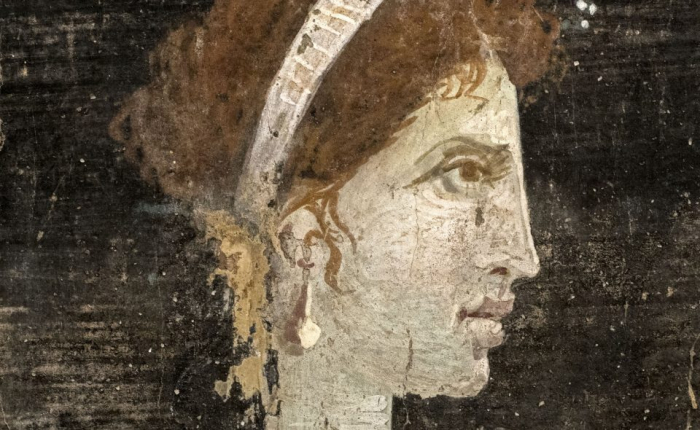Today many historians, under the influence of Sarah B. Pomeroy, an expert on the role of women in the ancient world, subscribe to the theory that Cleopatra’s looks—however pleasing they might have been—were ancillary to her considerable intelligence, learning, foresight, and strategic skills. The image of her as a sultry seductress likely stems from a narrative originally pushed by Octavian (Augustus) to rationalize his rivalry and conflict with fellow Roman Marc Antony, who was portrayed as having been manipulated by a foreign temptress. What’s more, casting Cleopatra as an evil beauty conveniently downplayed her competence and significance as a ruler.
While Roman historian Dio Cassius described Cleopatra as “a woman of surpassing beauty,” a number of modern historians have characterized her as less than exceptionally attractive. Nevertheless, they have noted that her beauty was heralded and that her appearance was seductive. Greek biographer Plutarch, writing about a century after Cleopatra’s death, presented a less flattering picture: "For her beauty, as we are told, was in itself not altogether incomparable, nor such as to strike those who saw her.” Plutarch, however, was quick to note Cleopatra’s “irresistible charm,” sweet voice, persuasiveness, and stimulating presence.
All that aside, there are artifacts that attest to Cleopatra’s appearance, though they are few in number. One of the most prominent, a marble bust dating to the third quarter of the 1st century BCE, is housed in the Old (Altes) Museum in Germany. This so-called Berlin Cleopatra depicts her wearing a royal diadem (headband-like crown). Her face is framed by ringlets of curly hair, and the rest of her hair is arranged in a “melon” style (divided into segments that run like the ribs of melon from the forehead back) and gathered into a bun behind her head. Her eyes are almond-shaped. Although her nose is prominent, her features are softly modulated and have been described as reflecting her intelligence and charm. Cleopatra’s hair is styled similarly on another marble bust, this one found in a villa on the Appian Way in 1784 and now displayed at the Vatican’s Gregoriano Profano Museum. On this bust too, her features are generally soft and her lips full. Her nose is missing, but its “footprint” on the face suggests that it was large.
An aquiline nose is the most prominent feature of the profiles of Cleopatra on contemporary coins (issued by Cleopatra or in her name) that are widely held to give the best representation of her appearance. On some of the coins, her nose is less hooked, her cheeks are full, and her chin is small, as on the marble busts. On other coins (especially those minted by Marc Antony, with his likeness on one side and hers on the other), her nose hooks dramatically, her forehead slopes broadly, her chin is pointy, and her face is more masculine.
In Hollywood, Cleopatra has been played by an array of stunning actresses. Elizabeth Taylor, who was put under the “gaze” as the “Queen of the Nile” in the best-known film version of the ruler’s story, Cleopatra (1963), is a mainstay on short lists of moviedom’s most attractive leading ladies. One of cinema’s first sex symbols, Theda Bara, invested her Cleopatra with dark sensuality in the lost silent classic Cleopatra (1917). Before the Production Code reined in sexual suggestiveness, a scantily clad Claudette Colbert caused a sensation in Cecil B. DeMille’s epic Cleopatra (1934), and Vivian Leigh was the beguiling queen in Caesar and Cleopatra (1945). But how did this image of Cleopatra come to be?
The obsession with Cleopatra as a looker started much earlier than movies: it started in literature and drama. In his play Antony and Cleopatra, William Shakespeare indelibly etched the queen’s portrait with these words:
Age cannot wither her, nor custom stale / Her infinite variety. Other women cloy / The appetites they feed, but she makes hungry / Where most she satisfies.
In his novel Cleopatra (1889), H. Rider Haggard was more direct in his description of the queen, who is a “Thing of Flame”:
Then I looked upon…that face which seduced Caesar….I looked upon the flawless Grecian features, the rounded chin, the full, rich lips, the chiselled nostrils, and the ears fashioned like delicate shells. I saw the forehead, low, broad, and lovely, the crisped, dark hair falling in heavy waves that sparkled in the sun, the arched eyebrows, and the long, bent lashes. There before me was the grandeur of her Imperial shape. There burnt the wonderful eyes, hued like the Cyprian violet.
Ultimately, new media depictions might do well to consider much less the fraught question of whether Cleopatra was beautiful and instead focus on the fact that she was considered charming, charismatic, and brilliant.
Read the original article on britannica.com.
More about: Cleopatra
















































